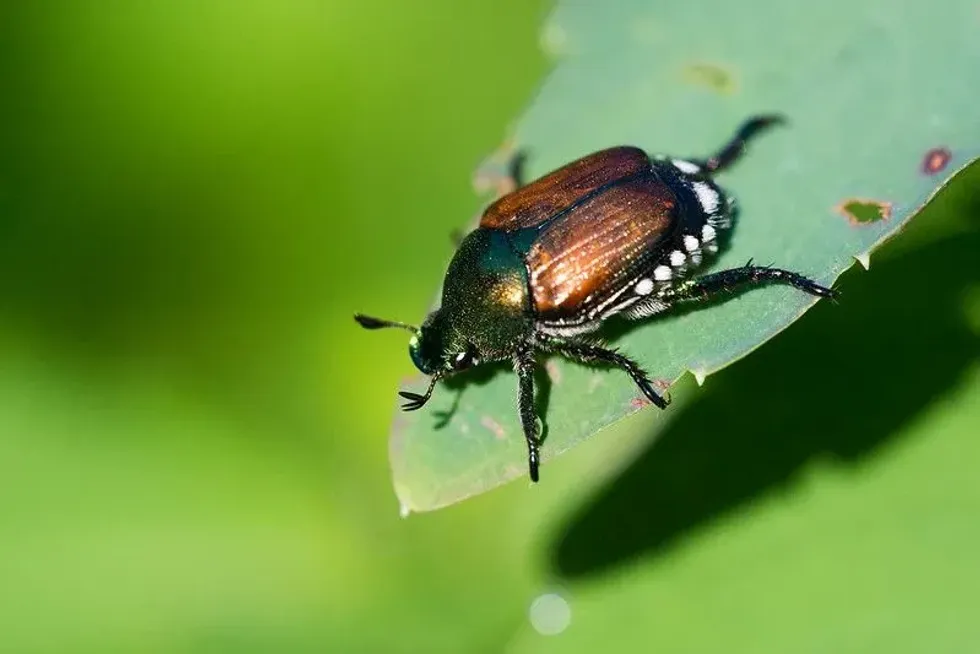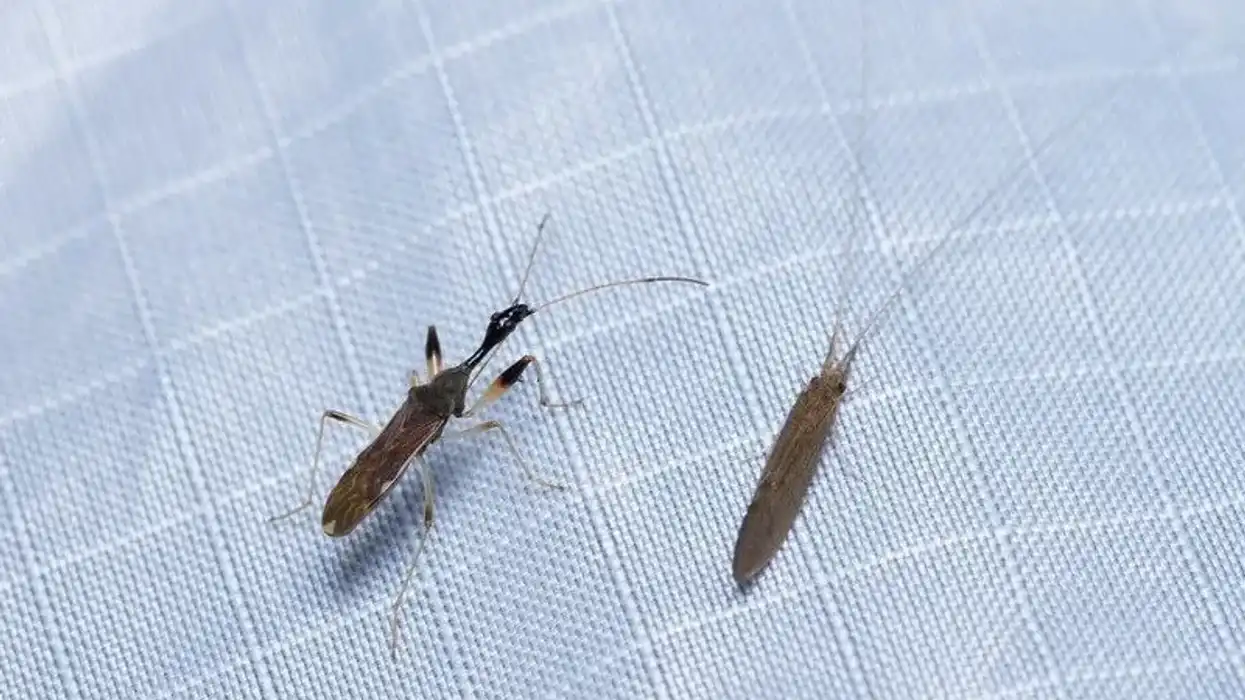Japanese beetle, also known as Popillia japonica, is a scarab beetle that is native to Japan and other East Asian countries. It was introduced into the United States by accident.
It is well known for its copper-colored elytra that are iridescent, measuring 0.6 in (1.5 cm) in length and 0.4 in (1 cm) in width. The head and thorax of this beetle are green in color, making it easy to spot.
Though the Japanese beetle is considered a pest in America, it is not found to be very destructive in Japan. The adults feed on nearly 300 different plant species, which include birch trees, grapes, hops, linden trees, canna, and crape myrtles.
Once the adult Japanese beetles feed on the leaves of a plant, what is left behind is just the veins, with no leaf material between them. It gives the plant a skeletal appearance, with the beetles feeding on the leaves and fruits.
In this article, we're going to take you through the most interesting facts about the Japanese beetle. Find out the top Japanese beetle facts for kids, along with things such as Japanese beetle control, feeding, and a lot more in this post.
For more facts-based articles right here on Kidadl, check out longhorn beetle facts and golden tortoise beetle facts.
Japanese Beetle Interesting Facts
What type of animal is a Japanese beetle?
Japanese beetle is a type of scarab beetle that is considered to be a pest in America. The adults feed on nearly 300 different species of plants.
What class of animal does a Japanese beetle belong to?
Japanese beetle (Popillia japonica) is a type of insect belonging to the Animalia kingdom, class Insecta.
How many Japanese beetles are there in the world?
The Japanese beetles are pests that were introduced into America in New Jersey in 1916, probably when the grubs were present in the root of an imported plant. It has grown significantly in numbers.
One swarm of Japanese beetles has been shown to destroy a peach tree in 15 minutes. Therefore, various pest control methods are being used against Popillia japonica to reduce their numbers and to prevent the beetles from feeding on economically important plants.
Where does a Japanese beetle live?
The Japanese beetle is native to Japan, but they do not cause as much destruction to plants as they do in America. They have been able to cope with the change in weather conditions between Japan and America.
A number of natural predators of the Japanese beetle have been able to control their numbers and, subsequently, the extent of their destruction in Japan.
What is a Japanese beetle's habitat?
The Japanese beetle feeding involves the consumption of nearly 300 species of plants, which means that it can live in parks, gardens, farms, or even in the trees and shrubs of forests. Sometimes, they are even found in the backyards of houses in the city. They form a nest and sleep on the ground at night.
Who do Japanese beetles live with?
Japanese beetles are typically found in groups, especially when they feed. They release a hormone called 'congregation pheromone' that attracts other Japanese beetles or insects. Though the damage caused to a plant by a single beetle may go unnoticed, the effect of the entire swarm is known to cause significant damage.
How long does a Japanese beetle live?
The grubs feed on the roots of plants and remain underground. The adult Japanese beetles are found to emerge from the ground during the month of June.
The adult Japanese beetles are most active for a period ranging from four to six weeks, after which these beetles die. They live for about 30-45 days in total.
How do they reproduce?
The life cycle of a Japanese beetle lasts for an entire year. The pupa stage lasts till mid of summer, which is when the adult beetles emerge. The beetles can fly short distances and are known to infest crops and plants that are further away.
When the weather is warm, these beetles descend on host plants and feed, along with which they mate to reproduce. After mating, the females lay about one to four eggs on moist soil. During the entire lifetime of a female Japanese beetle, she will lay between 40-60 eggs.
It takes nearly 14 days for the eggs to hatch and the larvae to come off the eggs. The larvae feed on the roots, remaining under the ground. During the cold winter season, they remain in the soil and hibernate.
During summer, the larvae are found closer to the surface of the soil, feeding on the roots. When it is warm, the larvae pupate for about 10 days, after which the adult Japanese beetle emerges to continue the life cycle.
What is their conservation status?
The Japanese beetle is considered a pest and is, therefore, not protected. Measures are being actively taken to control its numbers and to prevent the destruction of crops. In Japan, there are natural predators of this beetle that control its numbers. It is 'Not Listed' under the IUCN.
Certain predators of the adult beetles include wasps, moles, skunks, flies, and certain birds too. The natural enemy of the Japanese beetle is spring tiphia.
Birds feed on the grubs that come out of the soil, which also helps in reducing their numbers. The introduction of Bacillus popilliae, a bacterium that causes milky disease among the larvae, has been an important step towards controlling the numbers of this beetle.
Japanese Beetle Fun Facts
What do Japanese beetles look like?

The Japanese beetles, like most beetles, are found to have a hard exoskeleton with chewing mouthparts. The size of the mature Japanese beetle is between 0.4-0.6 in (1-1.5 cm), and it has a long metallic body color.
The wings have a bronze hue, while the body has a metallic green or blue hue. The brown wing covers that seem hardened are actually wings that have been modified, called elyptra. The wing covers are a characteristic feature at this stage.
The female Japanese beetle lays one to four eggs after mating, and these eggs are nearly translucent. They are white in color, round in shape, and measure 0.07 in (0.2 cm) in diameter.
The Japanese beetle grubs that hatch out of the eggs are grey in color, which is due to the deposit of soil and the aggregation of fecal matter in the hindgut. The head of the larvae are dark brown in color, and they measure about 1 in (2.5 cm) in size.
They are C-shaped and have three pairs of legs. When they are turned upside down, a V-shaped pattern of spines is visible, which helps in distinguishing them from other beetles.
The size of the pupa is 0.5 in (1.3 cm), with a tan color, unlike the metallic green colors present on the adult Japanese beetles. The appendages of the larvae are closely pressed against its body.
How cute are they?
Japanese beetles are not associated with cuteness quotient as they are considered to be pests. They look like any other common beetles, but they have a distinct metallic green color that helps identify them.
How do they communicate?
Japanese beetles communicate with each other by secreting pheromones that are carried by the wind to other beetles. The pheromones are usually secreted when beetles feed on their favorite plants like grapes, crimson-king, or even roses.
They are able to travel longer distances and fly up to 5 mi (8 km), moving from one farm to another. This has led to them being termed as pests, with active measures taken to control their numbers.
The swarms of Japanese beetles are formed responding to the pheromones of beetles that have found food, with swarms known to destroy a peach tree in 15 minutes. They feed on leaves, flowers, and fruits, while the larvae or the Japanese beetle grubs feed on the roots. The grubs are found in the soil.
How big is a Japanese beetle?
Japanese beetle, also known as Popillia japonica, is a scarab beetle that measures 0.6 in (1.5 cm) in length and 0.4 in (1 cm) in width. The head and thorax have a metallic green color, which is a distinguishing feature.
How fast can Japanese beetles move?
Japanese beetles can swim and for a long time. It is not known how fast they swim.
How much does a Japanese beetle weigh?
Japanese beetle adults weigh 0.0002 lbs (0.00008 kg).
What are the male and female names of their species?
There are no separate names for male and female adults of the Japanese beetles.
What would you call a baby Japanese beetle?
Baby Japanese beetles, or in the immature stage, are called grubs or white grubs.
What do they eat?
The Japanese beetles feed on 300 different species of plants, which include peach, soybeans, rose, hibiscus, and grapes.
The sharp chewing mouthparts of the adults result in the loss of leaves, flowers, and even fruits, leading to skeletonized leaves of various trees and shrubs. Only the vascular regions of the plants are left behind after the Japanese beetles have ravaged them. The flowers give a shredded appearance, while the fruits look hollow and chewed into.
The white grubs remain underground in the soil, feeding on roots of grass-like plants. The grubs are considered to be turf pests, as they destroy lawns and natural sports turfs.
The grubs feed on turf roots and make turf brown and roll up like a carpet. The Japanese beetle grubs feed on the roots of the turf, resulting in browning of the turf and a rolled-up appearance.
Are they harmful?
They are not poisonous, but they are destructive. The Japanese beetle damage to economically important plants has made them one of the dreaded pests in the U.S. They are of no economic importance and found to cause economic loss.
Would they make a good pet?
Japanese beetles are not meant to be pets. They are found in swarms and are known to devour peach trees within 15 minutes. The trees that have been infested with these Japanese beetles look bare, with no fruits, flowers, or leaves. When the Japanese beetles feed on the leaves, only the veins are left behind.
Did you know...
Japanese beetles are native to Japan, and since there are natural predators there, they do not cause much damage to plants. However, since the time they were introduced in 1916 in New Jersey, Japanese beetle damage to plants in the U.S has been considerable.
They are found in Georgia, in North America, till Missouri, from east to Nova Scotia, and from north till Ontario. There are even swarms that have been identified in California.
Getting rid of Japanese beetles
Japanese beetle control is important. Without Japanese beetle control measures, a lot of damage may be sustained, both from an environmental and an economic perspective.
An all-natural ingredient to kill Japanese beetles is four tablespoons of dish soap mixed with water and added to a bottle. This mixture can be sprayed on all the plants that attract the beetles and will prevent Japanese beetles from surviving. This won't hurt bees either and will keep the beetles away from harm.
In a bucket of water, apple cider vinegar and water should be mixed in equal parts. The beetles should be knocked into the mixture. The acid will kill them.
Alternatively, Japanese beetles hate the smell of these plants and are not known to attack them. Such plants include marigolds, onions, chives, larkspur, white geraniums, and onions.
The Japanese beetle's origins
Even though the presence of these beetles was first reported in the early 20th century in the USA, Japanese beetles are native to the northern reaches of Japan.
Here at Kidadl, we have carefully created lots of interesting family-friendly animal facts for everyone to discover! Learn more about some other arthropods from our atlas beetle facts and millipede facts pages.
You can even occupy yourself at home by coloring in one of our beetle coloring pages.









